stop start Lancia Thesis 2007 Owner handbook (in English)
[x] Cancel search | Manufacturer: LANCIA, Model Year: 2007, Model line: Thesis, Model: Lancia Thesis 2007Pages: 386, PDF Size: 8.69 MB
Page 209 of 386

PARKING SENSOR
The parking sensor provides dis-
tance information to the driver when
the car moves near obstacles placed
in front of and behind it.
The information on the presence
and distance of obstacles is sent to
the driver by means of sound sig-
nals, the frequency of which
depends on the obstacle distance.
By integrating the direct visual
information with the sound signal
emitted by the system, the driver can
therefore avoid possible collisions.
208
The responsibility for
parking manoeuvres and
other dangerous manoeu-
vres always rests with the driver.
When performing such manoeu-
vres, always make sure that no
persons or animals stand in the
area where the car is to be
parked. The parking assist sys-
tem should be considered as an
aid to the driver; in any case,
greatest attention must be paid
when performing dangerous
manoeuvres, even at low speed.
The system front and rear sensors
are activated automatically when
engaging reverse with the ignition
key at MAR. Disengaging the
reverse gear will turn the rear sen-
sors off; front sensors will stay on
until 15 km/h speed is exceeded to
allow concluding the parking
manoeuvre.Front sensors can be switched on
by pressing button A(fig. 155)
placed on the central console in
front of the gear lever; when the
front sensors are on, warning light
Blights up on the button. To
switch the sensors off, press button
Aagain.
When the sensors are on, the sys-
tem starts sending out sound sig-
nals from the front or rear buzzers
as soon as an obstacle is detected;
the signal frequency increases as
the obstacle gets nearer. When the
obstacle is at a distance of less than
30 cm, a continuous sound is emit-
ted. Depending on the position of
the obstacle (in front or behind),
the sound will be emitted from the
corresponding buzzer (front or
rear). The sound signal will imme-
diately stop if the distance from the
obstacles increases. The tone cycle
remains the same if the distance
measured by the central sensors
does not change; however, if this
condition occurs with side sensors,
the signal will be interrupted after
about 3 seconds, to avoid, for
instance, sending out signals in
case of parking manoeuvres along
walls.
fig. 155
L0A0016b
Page 225 of 386
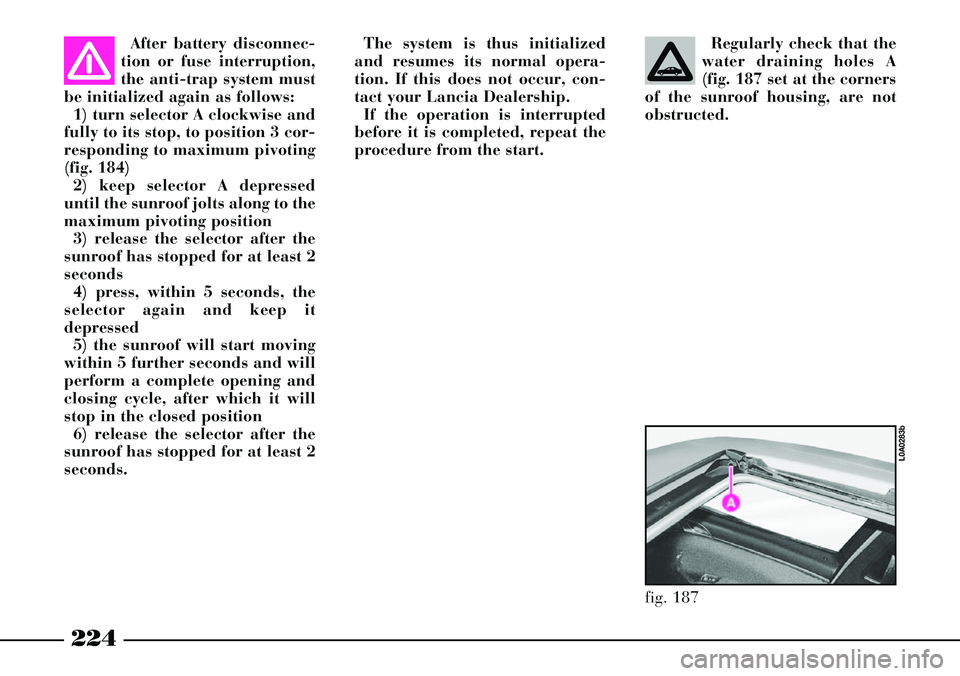
224
After battery disconnec-
tion or fuse interruption,
the anti-trap system must
be initialized again as follows:
1) turn selector A clockwise and
fully to its stop, to position 3 cor-
responding to maximum pivoting
(fig. 184)
2) keep selector A depressed
until the sunroof jolts along to the
maximum pivoting position
3) release the selector after the
sunroof has stopped for at least 2
seconds
4) press, within 5 seconds, the
selector again and keep it
depressed
5) the sunroof will start moving
within 5 further seconds and will
perform a complete opening and
closing cycle, after which it will
stop in the closed position
6) release the selector after the
sunroof has stopped for at least 2
seconds.The system is thus initialized
and resumes its normal opera-
tion. If this does not occur, con-
tact your Lancia Dealership.
If the operation is interrupted
before it is completed, repeat the
procedure from the start.Regularly check that the
water draining holes A
(fig. 187 set at the corners
of the sunroof housing, are not
obstructed.
fig. 187
L0A0283b
Page 251 of 386

250
STARTING
THE ENGINE
IMPORTANTThe car is equipped
with electronic engine immobilising
system. If the engine fails to start,
see paragraph “Lancia CODE sys-
tem”.
We recommend that
during the initial period
you do not drive to full
car performance (e.g.: excessive
accelerations, long journeys at
top speed, sharp braking etc.).It is dangerous to let the
engine run in a garage or
other closed area. The
engine consumes oxygen and
gives off carbon oxide, a poiso-
nous gas.
The ignition device is fitted with a
safety device which obliges the dri-
ver to return the key to STOPposi-
tion before repeating the starting
procedure.
In the same way, when the engine
is running, this device prevents any
shift from MARto AVV.Never leave the ignition
key at MAR when the
engine is off to prevent
battery draining due to current
absorption.
DRIVING YOUR CAR
Page 252 of 386

251
HOW TO START PETROL
VERSIONS
IMPORTANTNever press the
accelerator before the engine has
started.
1) Ensure that the electric parking
brake is on (instrument panel warn-
ing light xon).
2) Ensure that electrical systems
and devices, especially high absorp-
tion ones (e.g. heated rear window),
are off.
3) On versions with manual gear-
box, set the gear lever to neutral and
press the clutch pedal fully down to
avoid the starter dragging the gears.4) On versions with electronic
automatic gearbox, ensure that the
selector is at Pand keep the brake
pedal pressed.
5) Turn the ignition key to AVV
and release it as soon as the engine
starts.
6) If the engine fails to start, return
the key to STOPand repeat the pro-
cedure.
IMPORTANTIf the engine does
not start at the first attempt, do not
keep turning the ignition key to
avoid damaging the catalyst.
Contact a Lancia Dealership.HOW TO START JTD VERSIONS
1) Ensure that the electric parking
brake is on (instrument panel warn-
ing light xon).
2) Put the gear lever to neutral.
3) Turn the ignition key to MAR.
4) Wait until the mwarning light
is off: the hotter the engine is, the
quicker this will happen.
When the engine is particularly hot
the warning light may come on so
quickly that it is impossible to notice
it.
5)Press the clutch pedal down to
the floor.
6) Turn the ignition key to AVV
immediately after the mwarning
light goes out. If you wait too long,
you will lose the benefit of the work
done by the glow plugs.
Page 253 of 386

252
IMPORTANTEnergy-absorbing
devices (climate control system,
heated rear window etc.) are auto-
matically disconnected at starting.
If the engine does not start at the
first attempt, return the ignition key
to STOPbefore trying to start the
engine again.
If starting is particularly diffi-
cult,(with the Lancia CODE system
working properly) do not keep try-
ing too many times.
Use an auxiliary battery only if the
battery has insufficient charge.
Never use a battery charger to start
the engine. ENGINE WARMING UP
– Begin to move forward slowly let-
ting the engine turn at medium revs.
Do not accelerate abruptly.
– Do not push the engine to its limit
for the first few kilometers. You are
recommended to wait until the
coolant temperature has reached 50
to 60 °C.STOPPING THE ENGINE
– Release the accelerator pedal and
wait until the engine is idling.
– Turn the ignition key to STOP
and turn the engine off. For versions
with electronic automatic gearbox,
put the selector to Pbefore turning
the engine off.
IMPORTANTAfter a taxing drive
you should allow the engine to
“catch its breath” before turning it
off by letting it idle to allow the tem-
perature in the engine compartment
to fall.
Page 255 of 386
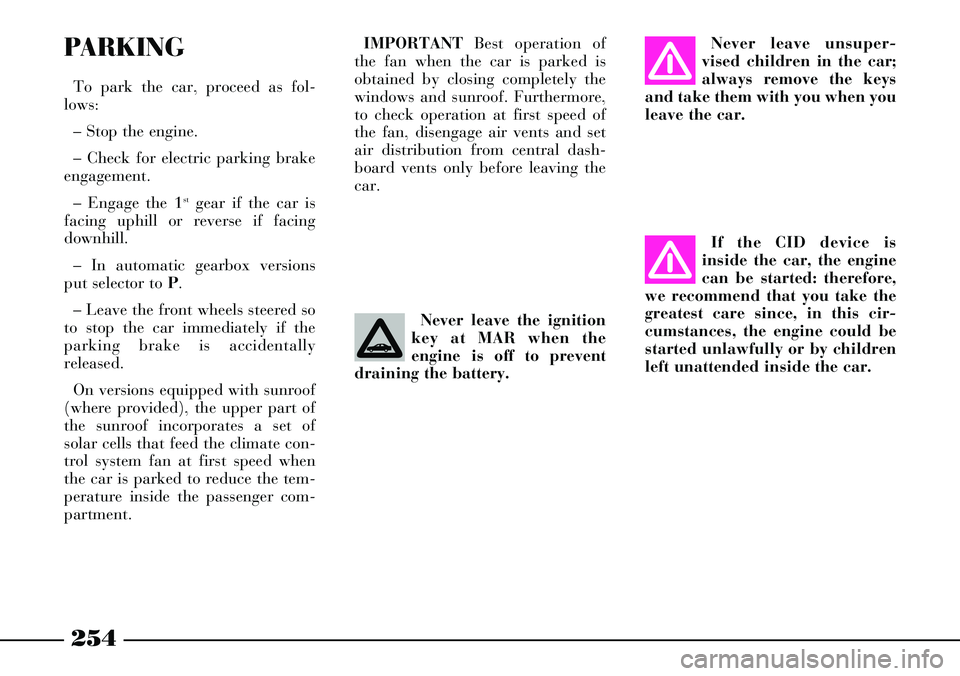
254
Never leave unsuper-
vised children in the car;
always remove the keys
and take them with you when you
leave the car.
If the CID device is
inside the car, the engine
can be started: therefore,
we recommend that you take the
greatest care since, in this cir-
cumstances, the engine could be
started unlawfully or by children
left unattended inside the car.PARKING
To park the car, proceed as fol-
lows:
– Stop the engine.
– Check for electric parking brake
engagement.
– Engage the 1
stgear if the car is
facing uphill or reverse if facing
downhill.
– In automatic gearbox versions
put selector to P.
– Leave the front wheels steered so
to stop the car immediately if the
parking brake is accidentally
released.
On versions equipped with sunroof
(where provided), the upper part of
the sunroof incorporates a set of
solar cells that feed the climate con-
trol system fan at first speed when
the car is parked to reduce the tem-
perature inside the passenger com-
partment.Never leave the ignition
key at MAR when the
engine is off to prevent
draining the battery.
IMPORTANT Best operation of
the fan when the car is parked is
obtained by closing completely the
windows and sunroof. Furthermore,
to check operation at first speed of
the fan, disengage air vents and set
air distribution from central dash-
board vents only before leaving the
car.
Page 258 of 386
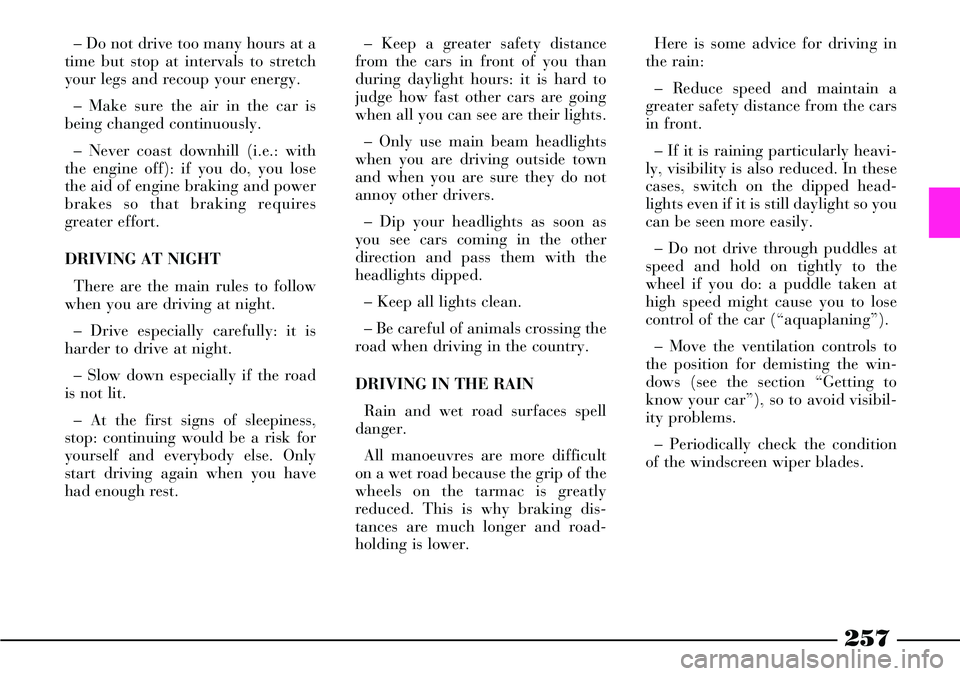
257
– Keep a greater safety distance
from the cars in front of you than
during daylight hours: it is hard to
judge how fast other cars are going
when all you can see are their lights.
– Only use main beam headlights
when you are driving outside town
and when you are sure they do not
annoy other drivers.
– Dip your headlights as soon as
you see cars coming in the other
direction and pass them with the
headlights dipped.
– Keep all lights clean.
– Be careful of animals crossing the
road when driving in the country.
DRIVING IN THE RAIN
Rain and wet road surfaces spell
danger.
All manoeuvres are more difficult
on a wet road because the grip of the
wheels on the tarmac is greatly
reduced. This is why braking dis-
tances are much longer and road-
holding is lower.Here is some advice for driving in
the rain:
– Reduce speed and maintain a
greater safety distance from the cars
in front.
– If it is raining particularly heavi-
ly, visibility is also reduced. In these
cases, switch on the dipped head-
lights even if it is still daylight so you
can be seen more easily.
– Do not drive through puddles at
speed and hold on tightly to the
wheel if you do: a puddle taken at
high speed might cause you to lose
control of the car (“aquaplaning”).
– Move the ventilation controls to
the position for demisting the win-
dows (see the section “Getting to
know your car”), so to avoid visibil-
ity problems.
– Periodically check the condition
of the windscreen wiper blades. – Do not drive too many hours at a
time but stop at intervals to stretch
your legs and recoup your energy.
– Make sure the air in the car is
being changed continuously.
– Never coast downhill (i.e.: with
the engine off): if you do, you lose
the aid of engine braking and power
brakes so that braking requires
greater effort.
DRIVING AT NIGHT
There are the main rules to follow
when you are driving at night.
– Drive especially carefully: it is
harder to drive at night.
– Slow down especially if the road
is not lit.
– At the first signs of sleepiness,
stop: continuing would be a risk for
yourself and everybody else. Only
start driving again when you have
had enough rest.
Page 259 of 386
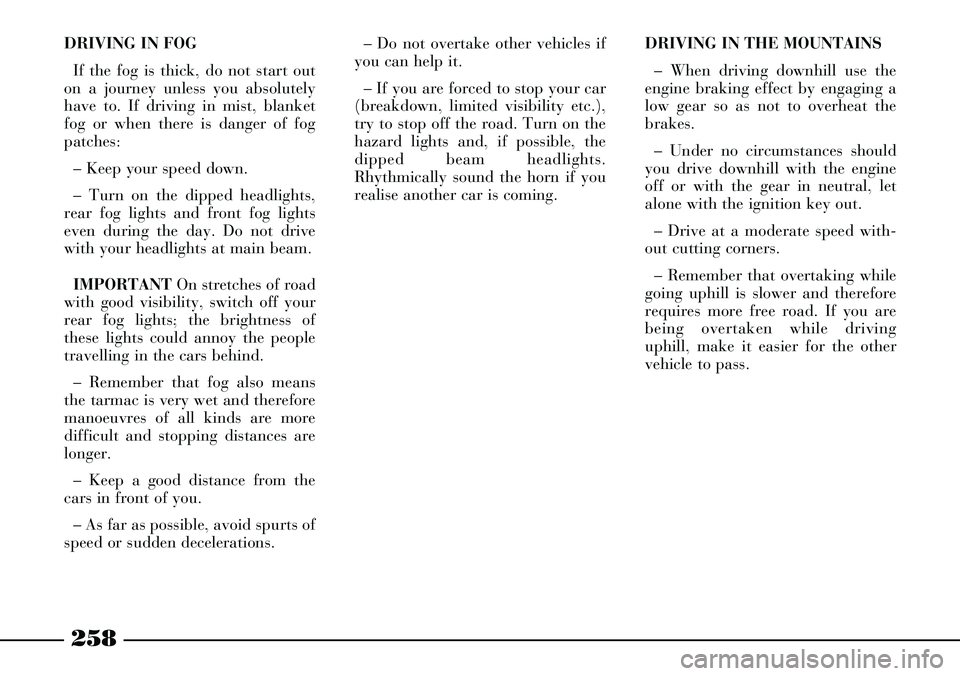
258
DRIVING IN FOG
If the fog is thick, do not start out
on a journey unless you absolutely
have to. If driving in mist, blanket
fog or when there is danger of fog
patches:
– Keep your speed down.
– Turn on the dipped headlights,
rear fog lights and front fog lights
even during the day. Do not drive
with your headlights at main beam.
IMPORTANTOn stretches of road
with good visibility, switch off your
rear fog lights; the brightness of
these lights could annoy the people
travelling in the cars behind.
– Remember that fog also means
the tarmac is very wet and therefore
manoeuvres of all kinds are more
difficult and stopping distances are
longer.
– Keep a good distance from the
cars in front of you.
– As far as possible, avoid spurts of
speed or sudden decelerations. – Do not overtake other vehicles if
you can help it.
– If you are forced to stop your car
(breakdown, limited visibility etc.),
try to stop off the road. Turn on the
hazard lights and, if possible, the
dipped beam headlights.
Rhythmically sound the horn if you
realise another car is coming. DRIVING IN THE MOUNTAINS
– When driving downhill use the
engine braking effect by engaging a
low gear so as not to overheat the
brakes.
– Under no circumstances should
you drive downhill with the engine
off or with the gear in neutral, let
alone with the ignition key out.
– Drive at a moderate speed with-
out cutting corners.
– Remember that overtaking while
going uphill is slower and therefore
requires more free road. If you are
being overtaken while driving
uphill, make it easier for the other
vehicle to pass.
Page 262 of 386
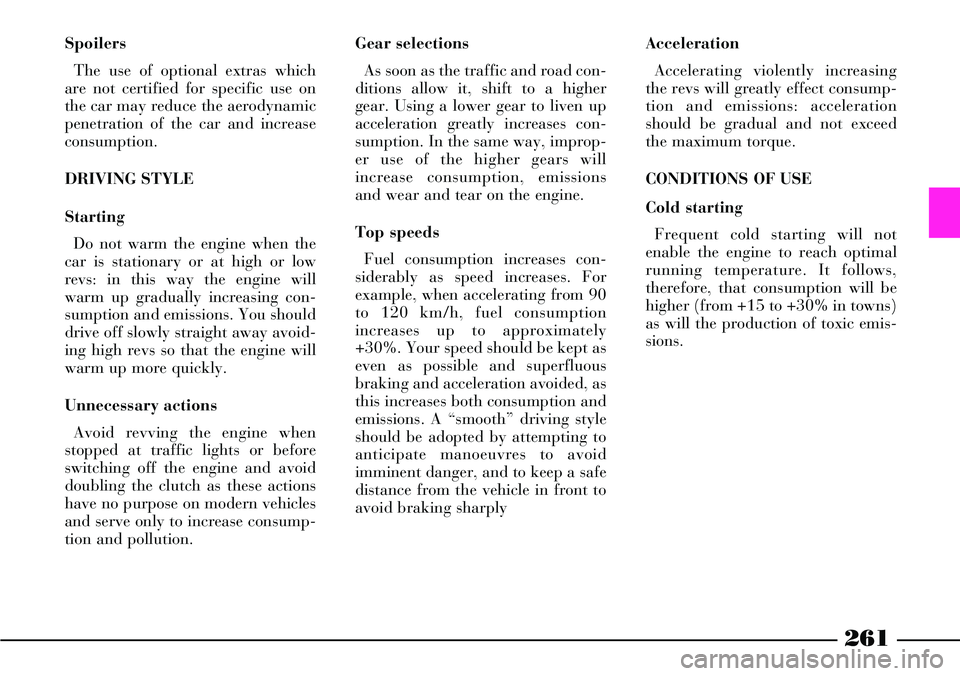
261
Gear selections
As soon as the traffic and road con-
ditions allow it, shift to a higher
gear. Using a lower gear to liven up
acceleration greatly increases con-
sumption. In the same way, improp-
er use of the higher gears will
increase consumption, emissions
and wear and tear on the engine.
Top speeds
Fuel consumption increases con-
siderably as speed increases. For
example, when accelerating from 90
to 120 km/h, fuel consumption
increases up to approximately
+30%. Your speed should be kept as
even as possible and superfluous
braking and acceleration avoided, as
this increases both consumption and
emissions. A “smooth” driving style
should be adopted by attempting to
anticipate manoeuvres to avoid
imminent danger, and to keep a safe
distance from the vehicle in front to
avoid braking sharplyAcceleration
Accelerating violently increasing
the revs will greatly effect consump-
tion and emissions: acceleration
should be gradual and not exceed
the maximum torque.
CONDITIONS OF USE
Cold starting
Frequent cold starting will not
enable the engine to reach optimal
running temperature. It follows,
therefore, that consumption will be
higher (from +15 to +30% in towns)
as will the production of toxic emis-
sions. Spoilers
The use of optional extras which
are not certified for specific use on
the car may reduce the aerodynamic
penetration of the car and increase
consumption.
DRIVING STYLE
Starting
Do not warm the engine when the
car is stationary or at high or low
revs: in this way the engine will
warm up gradually increasing con-
sumption and emissions. You should
drive off slowly straight away avoid-
ing high revs so that the engine will
warm up more quickly.
Unnecessary actions
Avoid revving the engine when
stopped at traffic lights or before
switching off the engine and avoid
doubling the clutch as these actions
have no purpose on modern vehicles
and serve only to increase consump-
tion and pollution.
Page 272 of 386

271
EMERGENCY
START-UP
If the Lancia CODE system cannot
deactivate the engine immobilising
system, symbols Yand Uwill
remain lit on the multifunction dis-
play together with messages
“ELECTRONIC KEY NOT
RECOGNISED” and “ENGINE
CONTROL SYSTEM FAULT”, and
the engine will not start. Follow the
emergency start-up procedure to
start the engine.
Read the whole procedure care-
fully before trying to carry it out.
If you make a mistake in the emer-
gency procedure you must turn the
ignition key back to STOP and
repeat the whole operation from the
beginning (step 1).
1) Read the five-digit electronic
code on the CODE card.
2) Turn the ignition key to MAR.3) Press and hold down the accel-
erator pedal. The warning light U
on the instrument panel will light up
for about 8 seconds, and then go
out. At this point release the acceler-
ator pedal and get ready to count the
flashes of the warning light U.
4) Count the number of flashes
that corresponds to the first figure of
the code on the CODE card, then
press the accelerator pedal and keep
it down until the Uwarning light
comes on for four seconds and then
goes out. Release the accelerator
pedal.
5) The Uwarning light will start
flashing again: after it has flashed
the number of times that corre-
sponds to the second figure on the
CODE card, press the accelerator
pedal to the floor and keep it there.
6) Do the same for the remaining
digits on the CODE card.7) Once the final figure has been
entered, keep the accelerator pedal
pressed. The Uwarning light will
light up for 4 seconds and then go
out. Release the accelerator pedal.
8) The Uwarning light will flash
rapidly for about 4 seconds to indi-
cate that the operation has been
completed correctly.
9) Start the engine by turning the
ignition key from MARto AVV
(without turning it to STOP).
If, however, warning light Ustays
on, turn the ignition key to STOP
and repeat the procedure from step
1).
IMPORTANTAfter an emergency
start, you should contact a Lancia
Dealershipimmediately as you will
have to repeat the procedure
described each time you want to
start the engine.
IN AN EMERGENCY